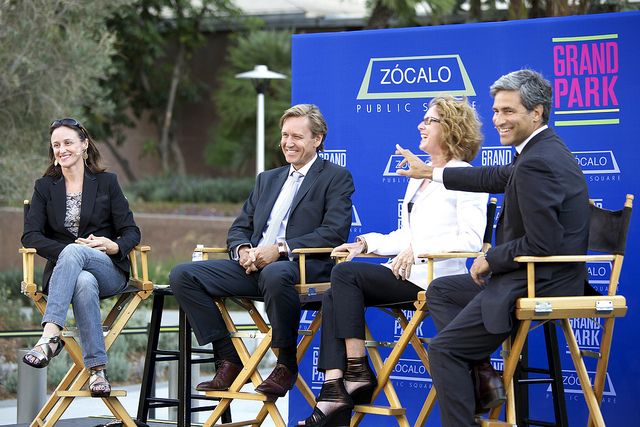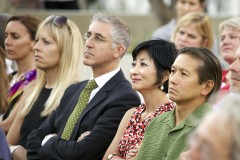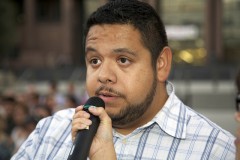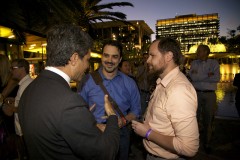
The museums of Los Angeles have enormous potential. But, said Jori Finkel, arts reporter at the Los Angeles Times, they “are also vulnerable.” A case in point is the Los Angeles Museum of Contemporary Art, which has been undergoing an identity crisis. Finkel was making this observation just a few blocks away from MOCA, in Grand Park, the latest addition to the major spaces of Los Angeles, at an event co-presented by KCRW in partnership with the Music Center. In conversation with her were the directors of three Los Angeles museums–Ann Philbin of the Hammer, Michael Govan of the Los Angeles County Museum of Art, and Timothy Potts, the new director of the Getty. In the audience was a large crowd filling Olive Court–nearly the width of the park–who had gathered to watch the discussion and enjoy the balmy Friday night.
What, Finkel asked the directors, should MOCA’s next steps be?
Philbin of the Hammer started the conversation by calling the recent “villainizing” surrounding MOCA and, especially, its director, Jeffrey Deitch, unfair. MOCA’s conflicts have deeper roots and cannot be ascribed to one person. Philbin said she hoped “something dramatic” would happen at MOCA–preferably “something wonderful like all the billionaires on the board decide to write very huge checks and save MOCA in a real way.” And while she didn’t offer strategies for the museum or for Deitch, she said that a weakened MOCA is bad for all of the city’s museums.
 Govan concurred with Philbin and noted that running a museum is harder than it looks, because museums are part of the public trust and subject to many different opinions about their direction. Ups and downs are inescapable for a contemporary art museum, “which is supposed to mimic the issues, the possibilities of the contemporary.” He doesn’t think the current controversies are the end of MOCA. “All I can say is, there’s a hope for the thrill of the future rise.”
Govan concurred with Philbin and noted that running a museum is harder than it looks, because museums are part of the public trust and subject to many different opinions about their direction. Ups and downs are inescapable for a contemporary art museum, “which is supposed to mimic the issues, the possibilities of the contemporary.” He doesn’t think the current controversies are the end of MOCA. “All I can say is, there’s a hope for the thrill of the future rise.”
The newcomer among the panelists was the Getty’s Potts, who had been on the job for all of 32 hours. But Potts has enough experience in the museum world–he has headed up the Kimbell Art Museum in Fort Worth, Texas, and the Fitzwilliam Museum at the University of Cambridge in England–to know that certain museum truths apply in any city. For instance, Potts said, it’s normal for museums to depend on the generosity of a small number of people–which often brings abrupt change and rocky periods.
But doesn’t Los Angeles, asked Finkel, have a particularly difficult time with cultural philanthropy?
Philbin of the Hammer said that a city like New York–where she directed the Drawing Center for nine years–has “the notion of the small giver” in place. There’s a tradition of small-sum donations in amounts such as $50 or $100. But, when she came to Los Angeles, she found that people seemed to think that only the rich were responsible for funding cultural institutions. She said she sees that mindset changing now, which she considers a vital change, because the middle class is what gives a city cultural vibrancy.
LACMA’s Govan said that the shallow roots of cultural philanthropy in L.A. are to be expected: LACMA was founded in 1961, while New York’s Metropolitan Museum of Art opened in 1872. “I truly feel it’s a matter of time,” he said, adding that giving becomes a family tradition as it is passed down from generation to generation. He sees that taking hold now in L.A. “It’s like the ’40s or ’50s or ’60s in New York, when institutions were being made, not being run, and I think that’s the exciting thing about being here right now,” Govan said.
 What, asked Finkel, about the myth that Hollywood doesn’t give locally in L.A.?
What, asked Finkel, about the myth that Hollywood doesn’t give locally in L.A.?
Philbin said that the nature of the business–a hit TV show can be canceled the following season, one film flop can derail a director’s career–makes fundraising in Hollywood difficult.
Govan, for his part, said that he doesn’t feel “we’ve been underserved by Hollywood recently.”
“We all know you have tapped Hollywood,” teased Philbin. “Come on!”
Donors aren’t the only local constituency art museums need; they also need local audiences. All three directors said that getting new audiences in is easy, but getting these visitors to return is more difficult. Philbin said that she often jokes that more people in Berlin know about the Hammer than people in Westwood, and she is trying to make the museum function as a Westside community center. Govan said that spectacle is a good start to drawing people in. “Levitated Mass”–the giant rock that traveled through the city to LACMA–was an excellent publicity stunt for the museum and part of a larger tradition. “The Egyptians built their pyramids as a PR stunt, and that worked pretty well,” he said.
The directors all said that through collecting and special exhibitions they are trying to reflect the city’s population and to support local art and artists. Potts pointed to the Getty-organized Pacific Standard Time project. Govan said that LACMA is focusing on collecting Asian and Latin American art as well as Southern California mid-century design. And Philbin pointed to the Hammer Contemporary Collection’s focus on art made in L.A. Sixty percent of the local artists whose work was featured in the Hammer’s “Made in L.A.” exhibition were born in other countries.
 In the question-and-answer session, the audience asked the panel to expand on what they were doing to bring their museums to more people. The directors talked about the pros and cons of free admission, how they’re bringing in younger visitors, and even addressed questions about parking. In response to the final question of the evening, about the $15 fee to park at the Getty, Potts said that he’d rather not charge, and that he’d wave a “magic wand” if he could to make parking free, but it’s logistically necessary because of a limited amount of spots.
In the question-and-answer session, the audience asked the panel to expand on what they were doing to bring their museums to more people. The directors talked about the pros and cons of free admission, how they’re bringing in younger visitors, and even addressed questions about parking. In response to the final question of the evening, about the $15 fee to park at the Getty, Potts said that he’d rather not charge, and that he’d wave a “magic wand” if he could to make parking free, but it’s logistically necessary because of a limited amount of spots.
But Govan said that there was a simple way for the audience to remedy this issue, with the subway coming to LACMA in 2019 and scheduled to reach the Hammer soon after. “If we really push, we can get it to the Getty, and we can solve that problem,” Govan said. “Everybody behind the subway!”
Watch full video here.
See more photos here.
Read what museum directors and scholars say is the secret behind a successful museum here.
*Photos by Jake Fabricius.
Ed. Note: The original version of this story quoted Govan incorrectly as saying the subway would reach LACMA in 2013. He, in fact, said 2019.




Send A Letter To the Editors